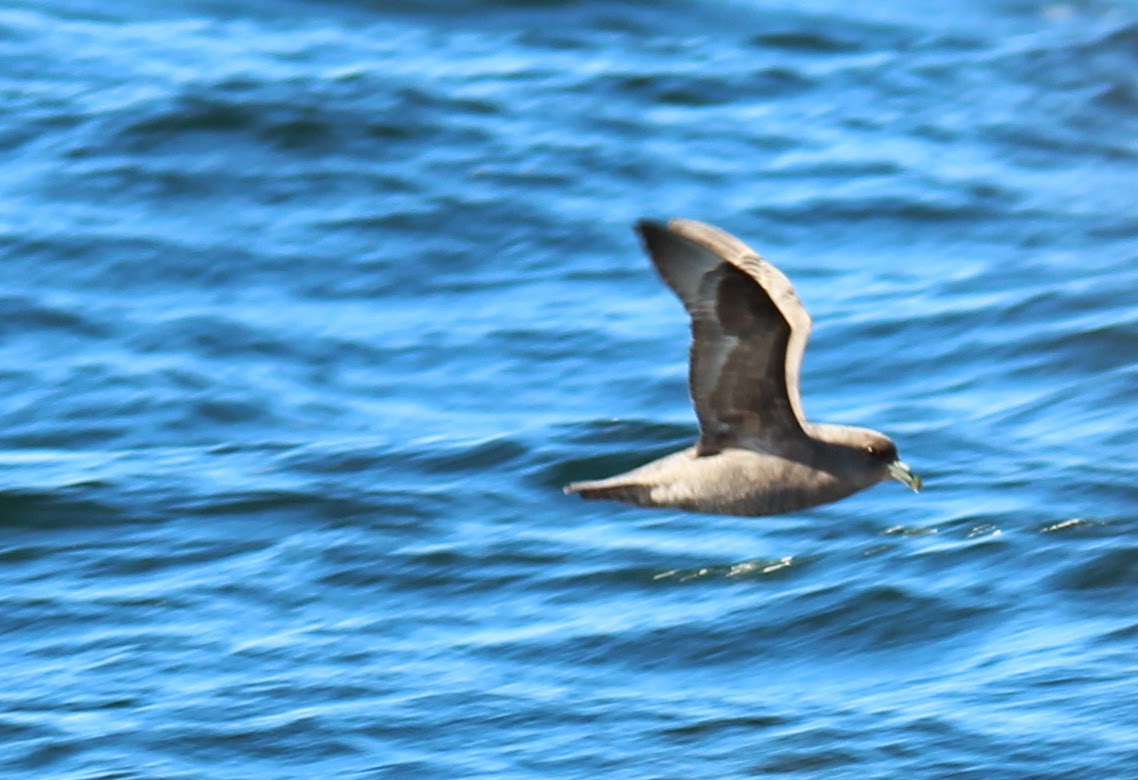The highlight of the trip was spotting two Parakeet Auklets. I tried to set a waypoint on my iPhone but the location it shows does not make any sense. My phone was accurate out to about 20 miles out, then it went crazy. I think we were about 27 miles offshore, open to being corrected.
The bird was sitting on very deep blue water. And the boat was rocking all over the place. SO this is a picture of it. (On top of picture)
Thank goodness you can zoom in on photos these days. You can see the hint of color in the bill. Through binoculars you could see the white plume and the shape was different than any other alcid. To me it looked long necked and "bill-less".
Another cropped picture.
Just for yucks, I lightened up one of the pictures to see if more color would come into play:
Out of focus , but you can see the white belly and more color to the bill. I think this was the second one we saw. Parakeet and Least Auklets have white bellies, Whiskered and Crested do not.
We chummed on two spots during the trip, both efforts yielded a good variety of birds. Mostly a variety of gulls (lots of Black-legged Kittiwakes) and Northern Fulmars, Laysan Albatross and Black-footed Albatross. We saw just one or maybe two Pink-footed Shearwater. No other shearwater were seen. Not surprised about the lack of Sooty, most of them are leaving New Zealand now heading this way. I was hoping for a Short-tailed. I had a suspected shearwater, but it was too low to the water to be seen well. It was probably a dark fulmar. We probably saw about 8 Laysan Albatross, a great day for the species.
Here are a few photos of some that we saw.
Black-footed Albatross were also out there.
Above is a typical view of birds on the ocean. Black-footed Albatross and what is the bird in between the two?
Northern Fulmars were common:
We did see several jaegars on the trip. All that I saw were either pestering gulls or were being chased by a ticked off gull.
Below I think is a Pomarine Jaegar. The boldly streaked uppertail coverts (compared to brown and buff stripes) and dark head point that way. Also the wide wings, wider than tail behind wing is Pomarine as well. I am not sure why I can't see a sharply bi-colored bill. But it is out of focus. Its flight style was like a large gull and it bulky shape is good for Pomarine as well. They are about Ring-billed Gull in size compared to a Mew Gull for Parasitic.
I lightened up the photo to show the double flash of a Pomarine and the underwing bars of a young bird. Not sure how old it is..
Lots of activity in the channel as well.
Barrow's Goldeneye with a Greater Scaup behind.
Greater Scaup and Surf Scoter
Common Loons in a variety of different plumage aspects.
Pacific Loon, note lack of white cut on neck and thinner bill.
California Sea Lions
Adorable face of a Harbor Seal
Only bad part of trip was I was dog tired, feel asleep and woke up sea sick on way home, ucky. Something that rarely happens to me in any sea state. I think my problem was I did not eat my normal snacks of crackers and cheese. Last time I'll make that mistake. No more cashews topped with chocolate mints.
Great trip, great birds and can't wait until May 17th.
I will add a species list tomorrow.
Thanks to MISTY, the crew, Russ, Tim and Dave.
Birds seen in channel:
Harlequin Duck
Surf Scoter
Bufflehead
Surf Scoter
Bufflehead
Common Goldeneye
Barrow's Goldeneye
Red-throated Loon
Pacific Loon
Common Loon
Horned Grebe
Western Grebe
Brandt's Cormorant
Double-crested Cormorant
Pelagic Cormorant
Brown Pelican
Common Murre
Pigeon Guillemot
Mew Gull
Western Gull
California Gull
Thayer's Gull
Glaucous-winged Gull
Red-throated Loon
Pacific Loon
Common Loon
Horned Grebe
Western Grebe
Brandt's Cormorant
Double-crested Cormorant
Pelagic Cormorant
Brown Pelican
Common Murre
Pigeon Guillemot
Mew Gull
Western Gull
California Gull
Thayer's Gull
Glaucous-winged Gull
Near shore:
Surf Scoter
White-winged Scoter Black Scoter
Red-throated Loon
Common Loon
loon sp.
Brandt's Cormorant
Pelagic Cormorant
Common Murre
Pigeon Guillemot saw several groups of four or so
Marbled Murrelet
Ancient Murrelet
Rhinoceros Auklet
Mew Gull
Western Gull
California Gull
Offshore:
Laysan Albatross
Black-footed Albatross
Pink-footed Shearwater
Northern Fulmar Common Murre
Ancient Murrelet
Parakeet Auklet photos taken, will post if I can
Rhinoceros Auklet
Black-legged Kittiwake
Western Gull
California Gull
Herring Gull
Thayer's Gull













































